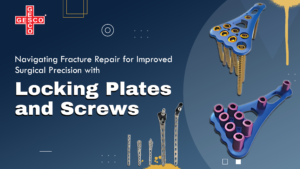One of the most frequent orthopedic injuries is a fracture, which can be caused by a variety of factors including trauma, overuse, or underlying pathological conditions. A sophisticated approach is necessary for the management of fractures, taking into account the patient’s age, general health, the location and severity of the fracture, and the quality of the affected bone. In order to promote appropriate healing and restore function, orthopedic surgeons have created and improved a number of methods for stabilizing fractured bones over time. Among these methods, the development of locking plates and screws has been a major breakthrough in fracture repair operations, providing patients with better stability and results.
Traditional plates and screws were usually used in traditional fracture fixation techniques. These methods were useful, but they had drawbacks, especially when treating fractures with poor bone quality or complicated fracture patterns. Achieving sufficient stability was a major problem with traditional fixation techniques, particularly in cases of poor bone-to-implant contact or fractures involving small bone fragments. Patients frequently experienced longer recovery periods, slower healing, and higher risks of implant failure as a result of this.
By fixing such problems, the development of locking plates and screws has completely changed the fracture repair landscape. By engaging with specialised screw holes in the plate, locking screws create a fixed-angle construct, in contrast to conventional screws that rely on friction between the screw head and plate to maintain stability. Because of this design, multidirectional fixation is possible, which improves stability even in situations where there are comminuted fractures or poor bone quality. The screws are firmly anchored into the plate.
The distinctive design of locking plates includes threaded screw holes that take locking screws at precise angles. By doing so, surgeons can precisely align and compress the fracture spot, resulting in the best possible healing environment. Locking plates also lessen the chance of stress concentration and implant failure by more evenly distributing the load along the bone. Because locking plates and screws come in a variety of sizes and shapes, they can be used in a broad range of anatomical locations and fracture types.
Locking plates and screws have various benefits over conventional fixation techniques in addition to their superior biomechanical properties. These advantages include:
1. Enhanced Stability: Locking screws create a fixed-angle construct that offers more stability, especially in fractures with complex fracture patterns or compromised bone quality.
2. Precise Alignment: Surgeons can precisely align fractured fragments, promoting optimal healing and lowering the risk of malunion or nonunion, thanks to the multidirectional fixation provided by locking plates.
3. Decreased Risk of Complications: Locking plates lessen the chance of problems like implant failure, nonunion, and misalignment by distributing load more equally throughout the bone.
4. Faster Recovery: Patients frequently recover more quickly thanks to the stability that locking plates and screws provide, which enables earlier mobilisation and rehabilitation.
5. Versatility: Because locking plates come in a range of sizes and shapes, surgeons can customise the fixation construct to meet the unique requirements of each patient and fracture pattern.
Accurately navigating fracture repair requires a solid grasp of biomechanical concepts in addition to competence with sophisticated fixation methods like screws and locking plates. Preoperative planning is essential to figuring out the best course of action in each fracture case. This includes thorough imaging studies and patient-specific considerations.
It is crucial to pay close attention to every detail during surgery. It is imperative for surgeons to guarantee accurate positioning of locking plates and screws, verifying appropriate alignment and compression throughout the fracture site. Fluoroscopy is one intraoperative imaging technique that can be used to confirm fixation and alignment accuracy.
Close observation of the patient’s recovery is necessary after surgery. Frequent follow-up appointments enable surgeons to evaluate the status of healing and modify the treatment plan as needed. Imaging studies can also be included in this process.
Hence, the introduction of locking plates and screws to fracture repair has transformed orthopaedic surgery by providing patients with better stability, accuracy, and better results. Orthopaedic surgeons now carry these sophisticated fixation techniques as indispensable tools in their toolbox, enabling them to more confidently and effectively manage fractures. The field of fracture repair has even more promise in the future as technology and our understanding of biomechanics grow. New developments could enhance patient care and outcomes.
visit our website now now to know more.

